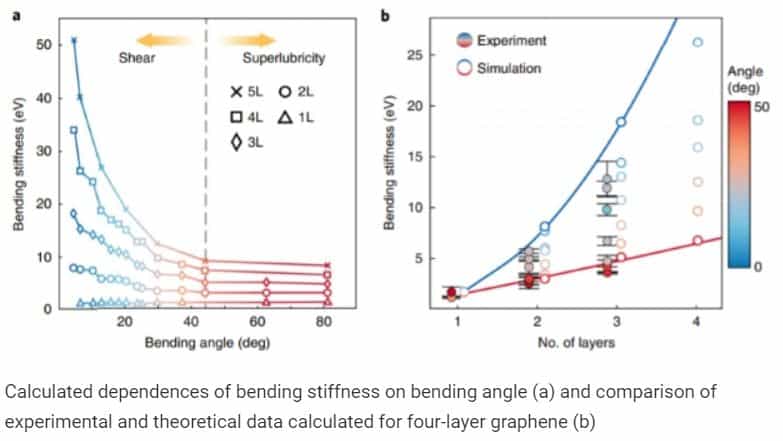A team of scientists experimentally determined and confirmed by calculations the energy of bending the film from multi-layered (up to 12 layers) of graphene. It turned out that at the angles of a large 40 degrees the layers glided relative to each other without friction and each of the planes had the same rigidity value when bending (about one and a half electronvolts). And the rigidity of graphene from ten layers was three orders of magnitude lower than the usual methods of mechanics of thin films predicted.
Graphene combines flexibility, strength, electronic conductivity and lightness, making it an attractive material for creating flexible electronic devices and nanorobots. However, the mechanical properties of graphene materials, which are important to take into account when developing new devices, are still not fully understood.
Edmund Han and colleagues from the University of Illinois at Urbana-Champaign created heterostructures from steps of hexagonal boron nitride of different heights coated with a multilayer graphene film (thickness from one to 12 layers) and studied their bending stiffness. Using a transmission scanning electron microscope, the researchers obtained 22 images of samples of multilayer graphene with a different number of layers on the surface of hexagonal boron nitride up to 19 layers thick. The bending profile of graphene was evaluated by the radius of curvature and the angle of bending.
Researchers evaluated how the conformation (position of atoms in space) of multilayer graphene varies depending on its thickness and step height from hexagonal boron nitride. The higher the step, the greater the bending angle, and the more graphene layers, the greater the radius of curvature. Scientists observed angles from eight and a half degrees to 63 degrees and a radius of curvature comparable to the internal radius of a nanotube — one nanometer.

The researchers found that when bending at angles of more than 40 degrees, the stiffness of each layer became the same (one and a half electron-volts), and the whole structure behaved like a stack of layers sliding without friction. These results show that at large bending angles, graphene layers begin to move relative to each other without friction. The rigidity in bending graphene from ten layers turned out to be only 18 electron volts – three orders of magnitude lower than the usual methods of mechanics of thin films predicted.
The results of the study will be useful in the development of two-dimensional materials and devices based on them, new strongly curved nanosystems and origami structures. The authors also note that although the work under discussion examined the behaviour of graphene, similar materials with Van der Waals connections may be bent.